Tempered glass is used for shower and patio doors, tabletops, and windows throughout our homes & businesses. But what is tempered glass and how is it made?
Tempered glass is a type of safety glass that is stronger than annealed glass and also safer – because when broken it forms harmless popcorn fragments.
Tempered glass, sometimes called “toughened” glass is made by heating annealed glass to about 1200 °F (650 °C) – a temperature at which it begins to soften. The outer surfaces are then cooled rapidly creating a solid skin of glass surrounding the still hot center. This procedure, called quenching, is done in a few seconds by high-pressure air blasting the surface of the glass from an array of nozzles in varying positions.
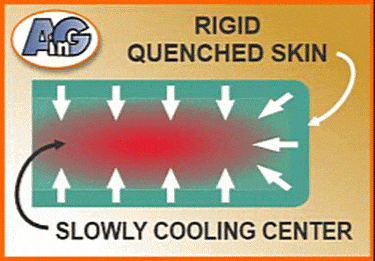
The glass is then cooled slowly so that the center of the glass contracts – pulling in on the solid surface skin. As a result, the outer surface comes under compression with an impact strength of 4 or 5 times that of annealed glass.
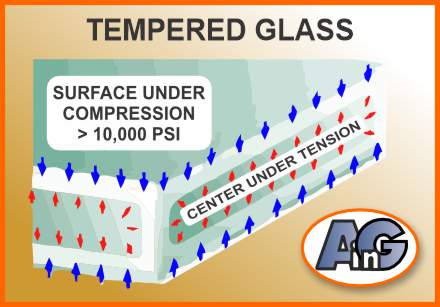
Tempered glass cannot be cut
It is vital to understand that glass, once tempered, cannot be cut, drilled or notched. Breaking the surface layer will result in explosive failure.
This means that all machining processes, cutting, edge-polishing, beveling, drilling, and grinding must be done before the glass is tempered. It also places a high premium on accurate measurements because the sizes cannot be changed.
Very minor modifications – polishing off 1/16″ from a side, or rounding the corners slightly can be made without the glass breaking but should only be done with care and by experts.
Read this post to investigate why it is not possible to cut tempered glass.
Production methods for tempering glass
There are two basic methods for manufacturing tempered glass:
- Glass is suspended vertically with tongs
- Glass is supported horizontally on rollers
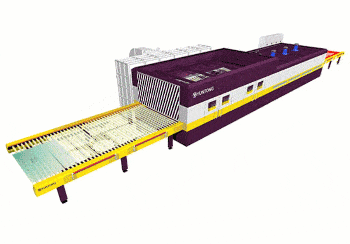
Both methods have pros and cons. In vertical tempering ovens, the tongs inevitably leave small impressions on the glass, whereas the rollers in a horizontal oven can produce characteristic waves or corrugations.
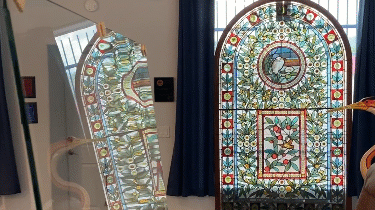
Tempered glass is identical in appearance (color, reflectance, translucency) to annealed glass but both tempering methods produce some degree of bow and warp. (This is most noticeable in long narrow panes where the edge effect can create warping sometimes referred to as “pretzelling”.)
Horizontal plants are the more modern type having the advantage of shorter processing time – giving greater output and avoiding tong marks.
Heat-strengthened (heat-treated) glass
An intermediate type of glass between annealed and fully tempered is called heat-strengthened glass and is produced by heating and cooling annealed glass in a process similar to that used in tempering.
The difference is that the glass is heated to 1150 °F (621 °C) – a temperature lower than that used for tempered glass – and the cooling process is slower.
Heat-strengthened glass is about twice as strong as annealed glass of the same thickness but not as strong as fully tempered glass.
Heat-strengthened glass is not a safety glass product as defined by the various code organizations but it does have greater resistance to thermal loads than annealed glass and, when broken, the fragments are typically larger than those of fully tempered glass.
Heat-strengthened glass is intended for windows in skyscrapers (curtain walls), where additional strength is desired to withstand wind load and thermal stress but where fully tempered glass is not necessary.
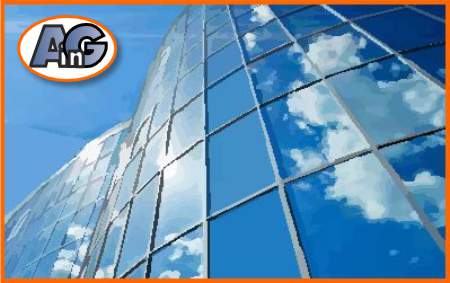
Heat-strengthened glass cannot be cut or drilled after heat-strengthening and any alterations, such as edge grinding, sandblasting or acid etching can cause premature failure.
Chemically tempered glass
Chemically tempered, also known as chemically strengthened, glass is made by the ion exchange process.
Glass is submerged in a bath containing potassium nitrate heated to about 570 °F (300 °C ) causing the sodium (Na+) ions on the surface of the glass to be replaced by larger potassium (K+) ions. It is the extra volume of the K+ ions, packed into the space vacated by Na+ ions that creates the state of compression and hence the strength of the surface.
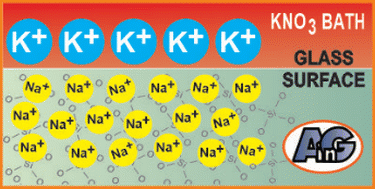
The most famous brand of chemically strengthened glass is Gorilla® glass made by the Corning® Glass company. Read this informative post for more about chemically strengthened glass.
Benefits of tempered glass
Tempered glass has numerous benefits compared with annealed (non-tempered) glass. In summary, tempered glass is:
- Tougher – four times more impact resistant
- Safer – breaks into harmless fragments
- Heat resistant
- Scratch-resistant
- Affordable
- Identical in appearance – color, clarity etc
Tempered glass is tougher
A vital quality of tempered glass is that it is 4-5 times more impact-resistant than annealed glass:;
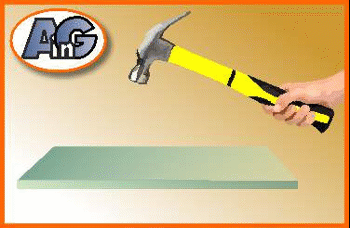
Do not try this at home – but tempered glass is very hard to break – even when hit with a hammer.
In contrast, annealed glass breaks easily and forms dangerous shards:
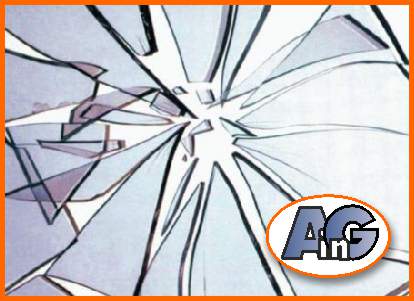
Safer – breaks into harmless fragments
Even though tempered glass is hard to break it will explode into a thousand pieces if you strike a vulnerable corner:
This breaking characteristic makes tempered glass relatively safe but it is important to note that it does not make your building secure. Broken tempered glass falls out of the window frame allowing bad guys to enter.
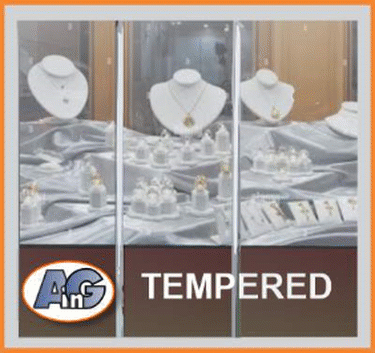
For building security, a different type of safety glass – laminated glass – is required.
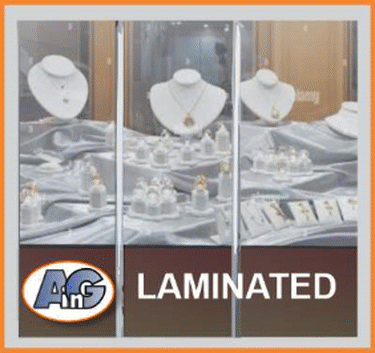
Read this post to learn all about safety glass and the relative benefits of tempered and laminated glass.
Tempered glass is heat resistant
Tempered glass resists thermal stress (uneven heating) – that’s why it is used for stovetop backsplashes and for the windows in ovens. Unlike tempered glass, annealed glass forms distinctive curvilinear stress cracks if it is heated unevenly.
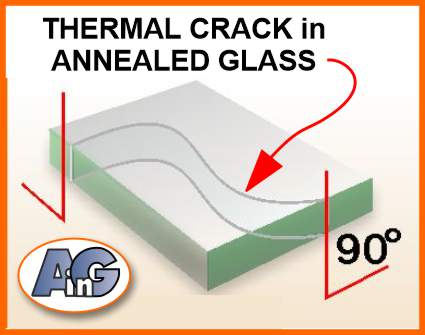
Placing a very hot saucepan directly on your annealed glass top will create a temperature gradient between hot and room-temperature glass. The internal structure of the glass becomes stressed as molecules attempt to accelerate in response to the asymmetrical heating. The result is very interesting, but unrepairable, curvilinear cracks in the glass.
As an Amazon Associate, I earn from qualifying purchases
Tempered glass is scratch-resistant
Tempered glass is much more scratch-resistant than plexiglass or polycarbonate:
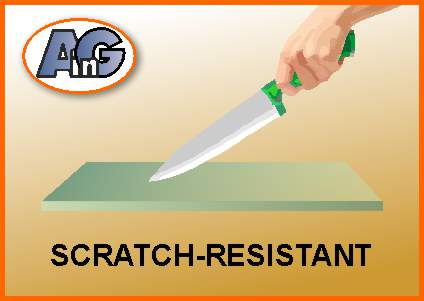
However, the surface of tempered glass is more brittle than that of annealed glass and therefore scratches slightly easier as the image below shows.
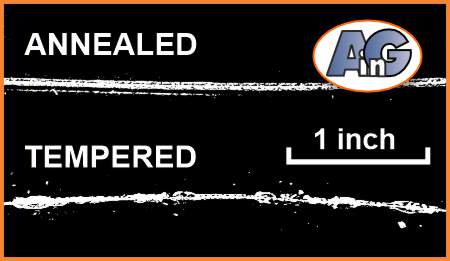
To learn all about scratches in glass tabletops – read this post. Always use placemats or trivets when using ceramic dishes on your glass tabletops.
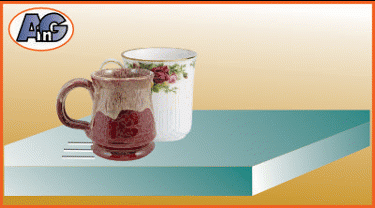
Tempered glass is affordable
The improvements in the manufacturing process mean that tempered glass is only slightly more expensive (10% – 15% more) than annealed glass. This means that, for many projects, it is prudent to play it safe and choose safety glass to protect your family against the unlikely event of glass breakage.
Price comparison for 1/4″ clear glass
Note that the figures above are approximate retail prices for Tucson customers in 2022. Your cost will vary and probably be higher in larger metropolitan areas.
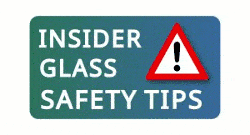
Always consult a professional if in doubt about glass safety. Read this post to find out if your glass tabletop should be tempered.
Tempered glass is identical in appearance
It is important to stress that, apart from the increase in hardness and the breaking characteristics, tempered glass is identical to annealed glass.


Tempered glass has the same color, clarity, chemical composition, light transmission, compressive strength, hardness, specific gravity, coefficient of expansion, thermal conductivity, and stiffness as annealed glass.
Uses of tempered glass
Tempered glass was developed as a way to minimize the risk of horrific injuries caused by razor-sharp shards of broken annealed glass. Read this post to learn all about injuries from broken glass and how to avoid them.
Safety codes mandate the situations where tempered glass should be used in residential and commercial buildings. Essentially, safety glass is compulsory anywhere there is a danger that people could walk into or fall through a glass window, door, screen, or tabletop.
The details of the building codes are complex but the drawing below summaries the most important locations for safety glass:
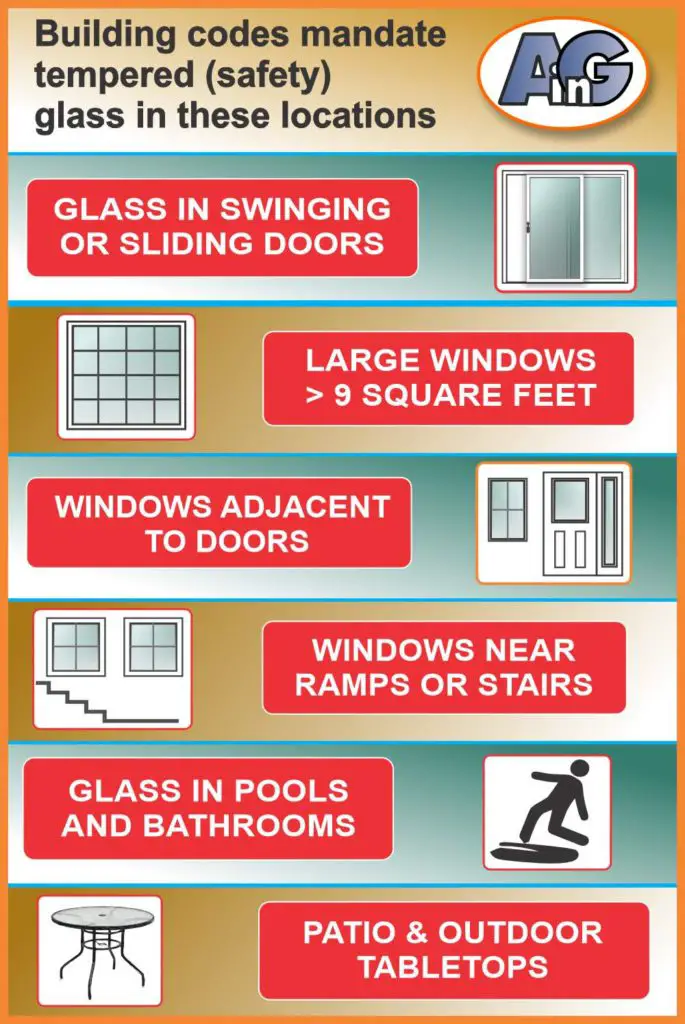
Don’t take chances with the safety of your family. Order a tempered glass tabletop with free shipping and great pricing from Amazon
Table comparing the uses of tempered & laminated glass
| Application | Tempered | Laminated |
| Shower Enclosures | X | |
| Tabletops | X | |
| Patio tables | X | |
| Shelves | X | |
| Kitchen backsplashes | X | |
| Greenhouse glass | X | |
| Exterior doors | X | X |
| Glass floors | X | X |
| Vehicle windshields | X | X |
| Hurricane resistance | X | |
| UV protection | X | |
| Soundproofing | X | |
| Storefront windows | X | |
| Security glass | X | |
| Colored art glass | X |
This tempered glass chair mat is scratch-resistant – ensuring long-lasting smoothness and protection.
Durable construction supports up to 1,000 lb.
The importance of tempered glass
The strength and safety of tempered glass has revolutionized the building industry. Now, very large strong, and safe windows can be engineered to bring light into buildings and to moderate temperatures.
Specially engineered tempered glass is used in spectacular structures like the sky deck at the Willis Tower in Chicago:
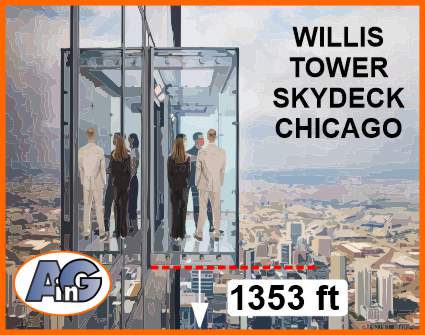
Glass safety – learn from the experts!
- Choosing between tempered & laminated glass
- Broken glass injuries and how to avoid them
- Is wired glass safe?
- What is safety glass?
- What is tempered glass?
- What is Gorilla Glass?
- Plexiglass vs glass
- Should glass shelves be tempered?
- Should glass tabletops be tempered?
- Is lead crystal dangerous?
- Is leaded (stained) glass dangerous?
- How to repair cracked stained glass
Glass tabletops & shelves – info from Artistry in Glass
- Benefits of glass shelving – info from experts!
- How much do glass tabletops cost?
- Do glass shelves need to be tempered?
- What is the best thickness for glass shelves?
- Best edge type for glass shelves, polished or beveled?
- How much weight can a wall shelf carry?
- What color glass should my shelves be?
- Glass tabletops – 10 amazing benefits explained
- How to order a glass tabletop
- Best thickness for glass tabletops – expert advice
- Should glass tabletops be tempered?
- Should glass tabletops be beveled?
- How to paint a glass tabletop
- All about tempering glass tabletops!
- How to tell if your glass is tempered
- Can tempered glass be cut?
- How to protect your wood table with glass
- How to fix a scratched glass tabletop
- How to fix a chipped glass tabletop
- How to replace broken patio table glass
- How to measure for a glass tabletop
- Video – how to measure your tabletop
- Plexiglass vs glass – pros and cons
- Beveled glass table base – a case study
- Choosing between tempered & laminated glass
- Glossary of terms used in the glass business




